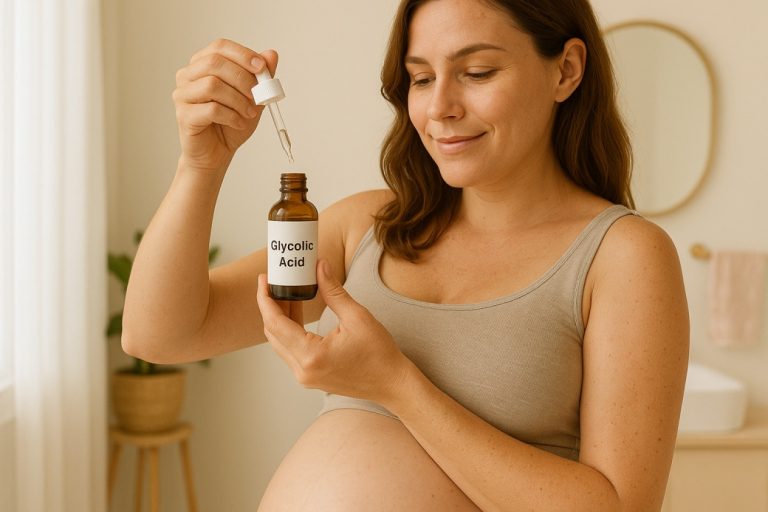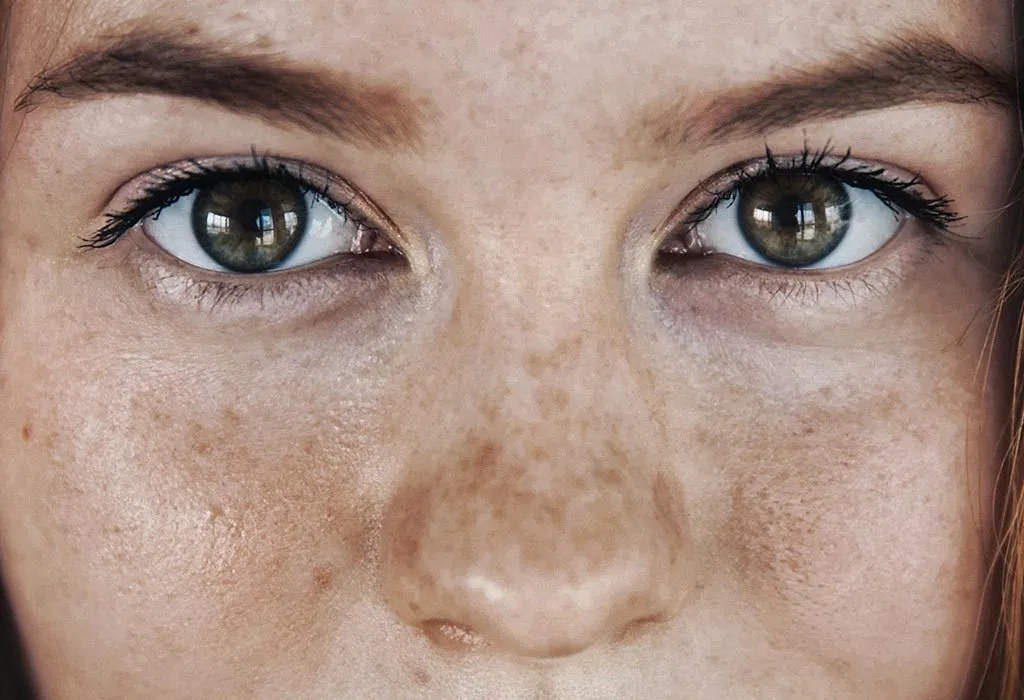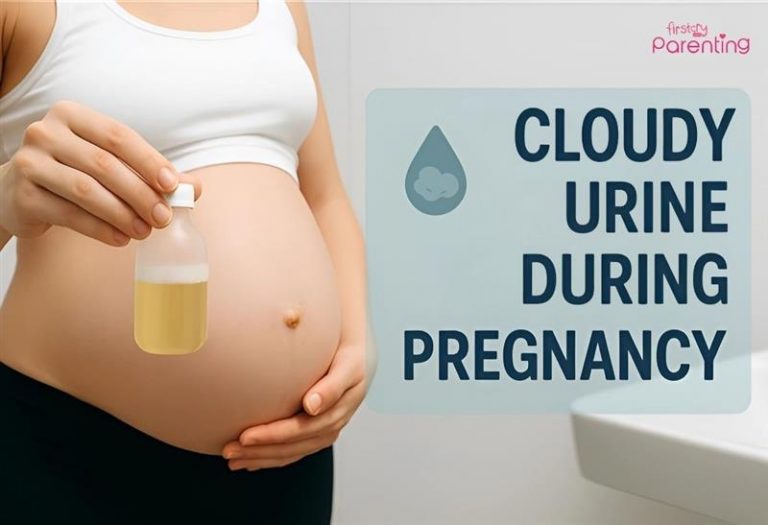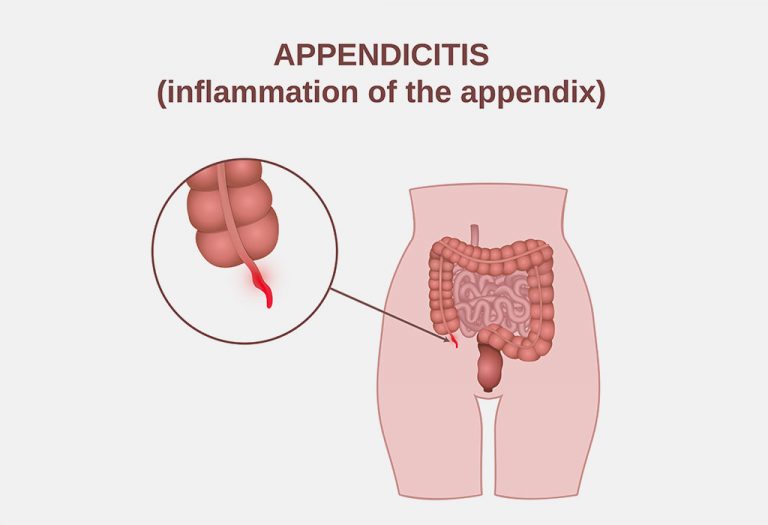Using Glycolic Acid in Pregnancy – Is It Safe
Everything you need to know about glycolic acid in pregnancy for clearer, healthier skin

When a woman becomes pregnant, she experiences plenty of hormonal changes. Increased production of the hormones progesterone and estrogen causes a lot of changes to skin tone and pigmentation in an expectant mother. Certain hormones tend to make the skin oily, causing acne eruptions and darkening of the skin around the eyes, nose, and cheeks (1). Glycolic acid can help restore the usual shine. But, with all skin sensitivities, is it safe to use glycolic acid when pregnant? To understand the relation between glycolic acid and pregnancy, we’ll first have to understand the basics of this potent ingredient. Glycolic acid is a substance that acts as an exfoliant to repair damaged skin, providing a youthful glow to the skin. Regular use of over-the-counter products with glycolic acid helps to counter skin-related issues during pregnancy.
What Is Glycolic Acid?
A part of the group of active compounds called AHAs (alpha hydroxy acids), glycolic acid is found in sugarcane. It has the smallest molecules in the group, which help to penetrate deep into the skin. This property makes it an excellent moisturiser and exfoliant, used to treat postinflammatory hyperpigmentation, blackheads, acne, dullness, and fine lines (2).
How Does It Work?
The acid contains tiny agents that eat the glue between cells. This loosens the structures that bind the dead skin cells to the epidermis (topmost layer of the skin). The acid reacts with the top layer by breaking down the sebum and other substances that bind the cells. Dead skin cells are then eroded, revealing youthful, brighter, and smoother skin. The acid also moisturises the skin that has been exfoliated.
Is Glycolic Acid Safe During Pregnancy?
Can I use glycolic acid when pregnant? Most expectant mothers with skin-related issues ask this question. Topical applications of glycolic acid in the form of lotions and creams with concentrations below 10% and final formulations above pH 3.5 are absolutely safe to use during pregnancy and breastfeeding (1) (3). The effect of the acid is restricted to the upper layer of the skin and does not penetrate into the bloodstream (4).
Scientists are of the general opinion that systematic absorption of the ingredient should not be a concern (5). In fact, glycolic acid products appear to be a safer option during pregnancy than products containing retinoids and high-dose salicylic acid.
However, medical experts do agree that complications could arise due to the chemical peel treatment during pregnancy, which poses a risk of inflammatory hyperpigmentation. Therefore, glycolic acid peel is not safe during pregnancy and is not recommended.
Benefits of Glycolic Acid in Pregnancy
Here are the benefits of using glycolic acid during pregnancy:
1. Decreased Mottled Pigmentation
Expectant mothers may face the problem of blotched or pigmented skin. Products containing appropriate concentrations of glycolic acid penetrate into the dermis and prevent the development of spots and wrinkles.
2. Excellent Exfoliant
The acid dissolves the dead skin, clearing the blocked pores, and exfoliates the skin to reduce blackheads.
3. Perfect Moisturiser
The acid moisturises the exfoliated skin to lend it a glowing effect, in combination with other substances.
4. Acne Remover
Glycolic acid is an effective treatment for pregnancy acne. Sebum and blockages of dead skin cells result in cystic acne, which can be treated with glycolic acid.
5. Prevents Premature Ageing
The acid intensifies cell turnover, making them stronger. It also improves elasticity. This reduces fine lines, making the skin look healthy, and thus reduces premature ageing.
Side Effects of Glycolic Acid While Pregnant
High concentrations of glycolic acid could have some prominent side effects:
1. Irritation of Skin
You could experience sensitivity to sunlight, burning sensation, pain, itching, and redness of the skin. You could even develop scars due to overuse of the acid.
2. Issues with Skin Pigmentation
Higher usage of glycolic acid during pregnancy could cause abnormal skin pigmentation. Eventually, it depletes the quality and tone of the skin, resulting in uneven spots.
3. Reproductive Effects
A few animal studies have demonstrated adverse reproductive effects when glycolic acid was administered in high doses, compared to what is typically used in topical cosmetic products in humans. Examination of the use of glycolic acid in human pregnancy has not been conducted. However, topical use of glycolic acid during pregnancy shouldn’t be of concern as minimal systemic absorption is expected (4).
Safe Measures to Be Taken
During pregnancy, skincare routines require careful consideration to ensure the safety of both the mother and the developing fetus. Glycolic acid, a common skincare ingredient, has raised concerns regarding its usage during pregnancy. Following specific precautions can help mitigate potential risks associated with glycolic acid while maintaining skin health.
1. Opt for Low Concentrations
It is crucial to choose skincare products containing glycolic acid with a concentration no higher than 10%. Higher concentrations may increase the risk of skin irritation, and the absorption of larger amounts into the bloodstream could potentially pose concerns during pregnancy. Stick to milder formulations to minimise any potential adverse effects.
2. Avoid Chemical Peel Treatments
Pregnant individuals should steer clear of undergoing chemical peel treatments that involve glycolic acid. Chemical peels, especially those with high concentrations of glycolic acid, can lead to significant changes in skin tone and quality. The potential risks associated with these treatments make them unsuitable during pregnancy, emphasising the need for caution.
3. Prioritise Patch Testing
Before incorporating any glycolic acid product into your skincare routine, perform a patch test to assess individual sensitivity. Hormonal changes during pregnancy may make the skin more susceptible to irritation. Patch testing helps identify potential adverse reactions, allowing for informed decisions about the safety and suitability of the product for personal use.
Alternatives to Glycolic Acid During Pregnancy
During pregnancy, concerns about skincare product safety often lead individuals to seek alternatives to ingredients like glycolic acid. Exploring alternative skincare options is crucial to maintaining healthy skin without compromising the well-being of the developing fetus. Here, we discuss several safe alternatives that can be incorporated into a pregnancy-friendly skincare routine.
1. Lactic Acid
Lactic acid, derived from sour milk or fermented fruits, is a milder alternative to glycolic acid. It offers gentle exfoliation and helps improve skin texture without the potential risks associated with stronger acids. Look for products with lower concentrations to ensure a safe yet effective option for pregnant individuals.
2. Mandelic Acid
Mandelic acid, extracted from bitter almonds, is another suitable substitute for glycolic acid during pregnancy. Known for its larger molecular structure, mandelic acid provides exfoliation without penetrating the skin as deeply, making it a gentler choice. It can help address skin concerns without causing irritation.
3. Enzyme-based Exfoliants
Opting for enzyme-based exfoliants is a non-acidic approach to promote skin renewal. Ingredients like papain (from papaya) and bromelain (from pineapple) possess natural exfoliating properties, aiding in the removal of dead skin cells without the use of traditional chemical exfoliants. These alternatives are generally well-tolerated during pregnancy.
4. Hyaluronic Acid
To maintain hydration and plumpness in the skin without resorting to exfoliating acids, consider incorporating hyaluronic acid into your routine. Hyaluronic acid is renowned for its ability to retain water, promoting moisturised and supple skin. This hydrating ingredient can be a safe and beneficial addition to pregnancy skincare.
When to Consult the Dermatologist?
Although over-the-counter products containing glycolic acid are safe for use during pregnancy, you should consult a dermatologist to avoid any side effects. If you have sensitive skin, it is best to talk to an expert to rule out harmful side effects.
FAQ
1. What percentage of glycolic acid is safe during pregnancy?
Most experts suggest keeping glycolic acid products at 10% or lower for cosmetic use in general and during pregnancy (6). Lower concentrations are effective for exfoliation and brightening without causing significant absorption or irritation. Higher-strength chemical treatments should be avoided unless approved by a dermatologist.
2. Can you get a glycolic peel during pregnancy?
Light glycolic acid peels, usually around 20% or less, may be allowed, but only when done by a trained professional and after getting medical clearance. However, no confirmation is present regarding its allowance during pregnancy. Thus, it is best to consult your doctor. Stronger clinical peels, including a strong glycolic peel during pregnancy, are typically discouraged because they can increase skin sensitivity and may pose unnecessary risks.
3. Is it safe to use glycolic acid while breastfeeding?
Yes, using glycolic acid while breastfeeding is generally considered safe. However, it is advisable to opt for products with lower concentrations (10% or less) and avoid chemical peel treatments. Additionally, patch testing is recommended to ensure individual skin tolerance. Consulting with healthcare professionals or dermatologists can provide personalised guidance based on specific circumstances.
So, this was all about glycolic acid and pregnancy. Glycolic acid can be beneficial for your skin problems during pregnancy, but it is best to use it after proper consultations with a dermatologist. Pregnancy can bring some skin issues, but they can be tackled with home remedies, too, and I hope this also answers your question “is glycolic safe during pregnancy” and gives you more clarity on using it safely.
Also Read:
Salicylic Acid in Pregnancy
High Uric Acid in Pregnancy
Consuming Antacids during Pregnancy
Is Amino Acid Safe for Pregnant Women?
Was This Article Helpful?
Parenting is a huge responsibility, for you as a caregiver, but also for us as a parenting content platform. We understand that and take our responsibility of creating credible content seriously. FirstCry Parenting articles are written and published only after extensive research using factually sound references to deliver quality content that is accurate, validated by experts, and completely reliable. To understand how we go about creating content that is credible, read our editorial policy here.
1. The American College of Obstetricians and Gynecologists – Skin Conditions During Pregnancy
2. PubMed Central – Postinflammatory Hyperpigmentation
4. PubMed Central – Safety of skin care products during pregnancy
5. ScienceDirect – A review of the safety of cosmetic procedures during pregnancy and lactation
6. PubChem; National Library of Medicine – Glycolic Acid
























